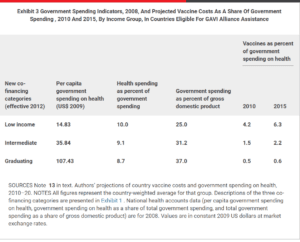 Immunization is one of the “best buys” in global health. However, for the poorest countries, even modest expenditures may be out of reach. The GAVI Alliance is a public-private partnership created to help the poorest countries introduce new vaccines. Since 2008 GAVI has required that countries cover a share of the cost of vaccines introduced with GAVI support. To determine how much countries can contribute to the cost of vaccines—without displacing spending on other essential programs—we analyzed their fiscal capacity to contribute to the purchase of vaccines over the coming decade. For low-income countries, external financing will be required to purchase vaccines supported by GAVI, so co-financing needs to be modest. Relatively better-off “intermediate” countries could support initially modest but gradually increasing co-financing levels. The countries soon to graduate from GAVI can generally afford to follow a rapid path to self-sufficiency. Co-financing for these countries needs to ramp up so that national budgets fully cover the costs of the new generation of vaccines once GAVI support ends.
Immunization is one of the “best buys” in global health. However, for the poorest countries, even modest expenditures may be out of reach. The GAVI Alliance is a public-private partnership created to help the poorest countries introduce new vaccines. Since 2008 GAVI has required that countries cover a share of the cost of vaccines introduced with GAVI support. To determine how much countries can contribute to the cost of vaccines—without displacing spending on other essential programs—we analyzed their fiscal capacity to contribute to the purchase of vaccines over the coming decade. For low-income countries, external financing will be required to purchase vaccines supported by GAVI, so co-financing needs to be modest. Relatively better-off “intermediate” countries could support initially modest but gradually increasing co-financing levels. The countries soon to graduate from GAVI can generally afford to follow a rapid path to self-sufficiency. Co-financing for these countries needs to ramp up so that national budgets fully cover the costs of the new generation of vaccines once GAVI support ends.
